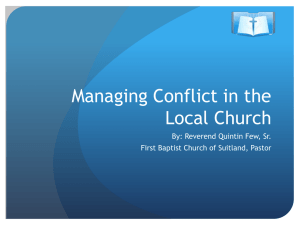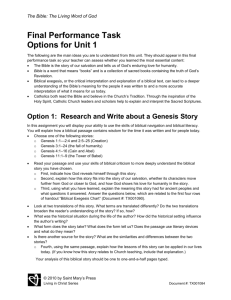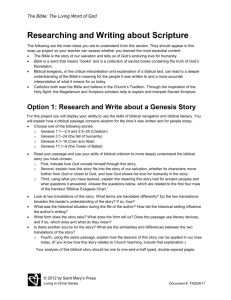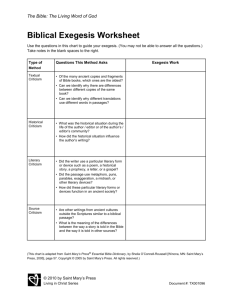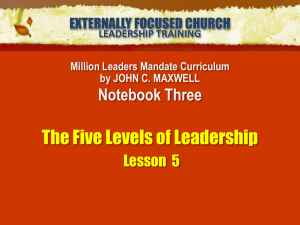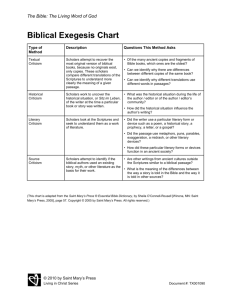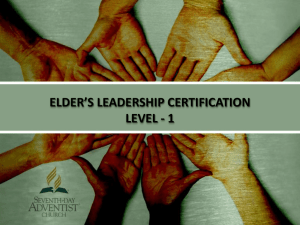B 300 - McCormick Theological Seminary
advertisement
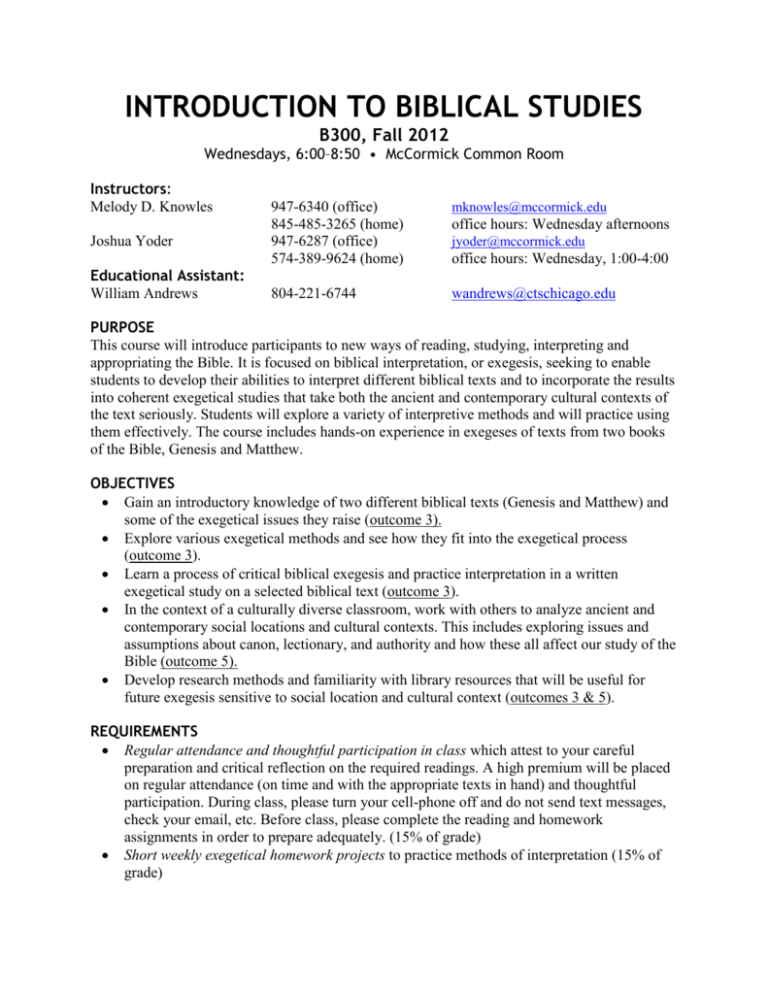
INTRODUCTION TO BIBLICAL STUDIES B300, Fall 2012 Wednesdays, 6:00–8:50 • McCormick Common Room Instructors: Melody D. Knowles Joshua Yoder Educational Assistant: William Andrews 947-6340 (office) 845-485-3265 (home) 947-6287 (office) 574-389-9624 (home) mknowles@mccormick.edu 804-221-6744 wandrews@ctschicago.edu office hours: Wednesday afternoons jyoder@mccormick.edu office hours: Wednesday, 1:00-4:00 PURPOSE This course will introduce participants to new ways of reading, studying, interpreting and appropriating the Bible. It is focused on biblical interpretation, or exegesis, seeking to enable students to develop their abilities to interpret different biblical texts and to incorporate the results into coherent exegetical studies that take both the ancient and contemporary cultural contexts of the text seriously. Students will explore a variety of interpretive methods and will practice using them effectively. The course includes hands-on experience in exegeses of texts from two books of the Bible, Genesis and Matthew. OBJECTIVES Gain an introductory knowledge of two different biblical texts (Genesis and Matthew) and some of the exegetical issues they raise (outcome 3). Explore various exegetical methods and see how they fit into the exegetical process (outcome 3). Learn a process of critical biblical exegesis and practice interpretation in a written exegetical study on a selected biblical text (outcome 3). In the context of a culturally diverse classroom, work with others to analyze ancient and contemporary social locations and cultural contexts. This includes exploring issues and assumptions about canon, lectionary, and authority and how these all affect our study of the Bible (outcome 5). Develop research methods and familiarity with library resources that will be useful for future exegesis sensitive to social location and cultural context (outcomes 3 & 5). REQUIREMENTS Regular attendance and thoughtful participation in class which attest to your careful preparation and critical reflection on the required readings. A high premium will be placed on regular attendance (on time and with the appropriate texts in hand) and thoughtful participation. During class, please turn your cell-phone off and do not send text messages, check your email, etc. Before class, please complete the reading and homework assignments in order to prepare adequately. (15% of grade) Short weekly exegetical homework projects to practice methods of interpretation (15% of grade) 2 Two exegetical exercises: Assignment 1: The Literary Shape of the Text (20% of grade, due Oct. 20) Assignment 2: Ancient Historical & Cultural World of the Text (20% of grade, due Nov. 14) A complete exegesis paper incorporating the revised versions of the two exercises above and including new material that pertains to your social and cultural location (30% of grade, due Dec. 12) These dues dates are mandatory, and there will be no unpenalized extensions. Do not plagiarize. Please consult the document “Use of Sources” housed with the syllabus on the moodle site. Please let the instructors know if you have any health or learning issues that impact your participation in this class and its methods of teaching and learning. REQUIRED TEXTBOOKS All texts are also on reserve or in the reference section of JKM. Two translations of the Bible: One of these should be a study Bible based on the New Revised Standard Version (NRSV), selected from the following list: The Harper-Collins Study Bible. Rev. ed. Edited by Harold W. Attridge. New York: HarperCollins, 2006. The New Interpreter’s Study Bible: New Revised Standard Version with the Apocrypha. Edited by Walter Harrelson. Nashville: Abingdon, 2003. The New Oxford Annotated Bible with the Apocrypha. 3rd ed. Edited by Michael Coogan. New York: Oxford University Press, 2001. The other should be the one your own religious community uses most, e.g. the King James Version (KJV) or the New International Version (NIV). You may also select as your second translation the new Common English Bible, published in 2011. For Genesis and the Old Testament: Coogan, Michael D. The Old Testament: A Historical and Literary Introduction to the Hebrew Scriptures. 2d ed. New York: Oxford University Press, 2011. Harrington, Daniel. Interpreting the Old Testament. Collegeville, MN: Liturgical Press, 1990. For Matthew and the New Testament: Harrington, Daniel. Interpreting the New Testament. Collegeville, MN: Liturgical Press, 1990. Throckmorton, Burton, Jr. Gospel Parallels. 5th ed. Nashville: Thomas Nelson, 1992. For theological research and proper citation of sources: Turabian, Kate L. A Manual for Writers of Term Papers, Theses, and Dissertations. 7th ed. Chicago: University of Chicago Press, 2009. 3 COURSE SCHEDULE AND READINGS September 5 Introduction: Studying the Bible in Ancient and Modern Worlds Our first class is an orientation to the course and to biblical study, examining issues such as social locations and contexts within a community of interpreters, the authority of the Bible, as well as questions such as what is biblical exegesis? In addition, there will be a short introduction to moodle. In preparation, please complete these two assignments: I. Write a paragraph (not more than a page) describing yourself and your community and the way you and your community read, study, and interpret the Bible. Write your paragraph by completing responses to the following statements: 1. My culture is/includes . . . 2. Aspects of my community that most affect my reading & interpretation of the Bible are . . 3. When I study the Bible my interpretation of it assumes that the biblical text is . . . Bring a hard copy to class and post an electronic copy on our course website in order to introduce yourself to the other members of the class. II. Select the text you would like to study for your in depth practice in biblical interpretation from the list of texts below. Select your three favorites from each book, Genesis and Matthew, and arrange your six favorite texts in order of preference. Genesis 9:1-17 Genesis 12:1-9 Genesis 16:1-16 Genesis 32:22-32 Genesis 45:1-15 Handouts: Matthew 8:5-13 Matthew 12:1-8 Matthew 14:22-33 Matthew 21:33-46 Matthew 28:1-10 Finding a Way into the Biblical Text Homework: Reading Through Genesis and Matthew – complete Matthew for next class (Sept. 12), Genesis for class September 19 PART I: ATTENDING TO THE LITERARY SHAPE OF THE BIBLICAL TEXT September 12 Form and Literary Analysis of Matthew Bring to class: homework: Reading Through Genesis and Matthew (Matthew only) your initial thoughts on Finding a Way into the Biblical Text Reading: the Gospel of Matthew (with reading guide on moodle) Mark Allen Powell, What is Narrative Criticism? (Minneapolis: Fortress, 1990), chapter 1, “Scripture as Story,” 1-10; chapter 4, “Events,” 35-44 only (44-50 will be useful for those writing on Matthew); chapter 5, “Characters,” 51-58 only; chapter 6, “Settings,” 69-75 4 only. For use in your exegesis, look over the questions for narrative analysis in the appendix: “Using Narrative Criticism in Exegesis,” 103-105, as well as in David Rhoads et al., Mark as Story (2d. ed.; Minneapolis: Fortress, 1999), 154-159. Harrington, NT, chapter 6: “Form Criticism,” 70-84. NB: For each chapter in Harrington, also consult the corresponding “Questions in Exegesis” at the back of the book (OT: Appendix; NT: Appendix 2) James Bailey and Lyle Vander Broek, Literary Forms in the New Testament: A Handbook (Louisville: Westminster John Knox, 1992), 98-122 (“Aphorism,” “Parable,” and “Pronouncement Story”). additional material on some types of sayings; will be especially helpful for those working on Matthew 21 Gerd Theissen, The Miracle Stories of the Early Christian Tradition (trans. Francis McDonagh; Philadelphia: Fortress, 1983), 43-74, 85-112. an example of intensive form-critical examination of one particular type of material (the miracle story); will be especially helpful to those working on Matthew 8 and 14 (and possibly 28) to skim Handouts: Plot and Character Development Introduction to Form Criticism Homework: A Guide to Reading Through Genesis and Matthew (posted on moodle for Sept 8) September 19 Form and Literary Analysis of Genesis Bring to class: homework: Reading through Genesis and Matthew (Genesis) Readings: Genesis (with reading guide on Moodle) Harrington, OT, chapter 1, “Basic Literary Criticism” and chapter 5, “Form Criticism” Handouts: Forms in the Hebrew Bible Stages in the Process of Composition Homework: Practicing Form Criticism Preparing for Source Criticism in Genesis September 26 The Sources of Biblical Literature – The Larger Compositions Within Books; Starting to write exercise 1 Bring to class: homework: Practicing Form Criticism; Preparing for Source Criticism in Genesis Reading: Harrington, OT, chapter 6, “Source Criticism and Redaction Criticism”; NT, chapter 5, “Source Criticism” Bart Ehrman, “The Synoptic Problem and its Significance for Interpretation,” in The New Testament: A Historical Introduction to the Early Christian Writings (3rd ed.; New York: Oxford University Press, 2004), 83-91. 5 Handouts: Exegesis Paper Hints for Literary Shape…Genesis From Key Themes to Thesis Hints for the Literary Shape…Matthew In Class Group work on Form/Source/Redaction Sources in Genesis Homework: Practicing Source Criticism October 3 Literary Form: The Redaction/Editing of Biblical Literature – Matthew *Workshop: Using ATLA and FirstSearch* Bring to Class: homework: Practicing Source Criticism Reading: Harrington, NT, chapter 8, “Redaction Criticism.” Mark Allen Powell, Fortress Introduction to the Gospels (Minneapolis: Fortress, 1998), 61-84. an overview of Matthew as redactor Handouts: In-class group work on Form/Source/Redaction Some Key Verbal Threads in Matthew Language for Jesus in Matthew Homework: Matthew as Redactor October 10 No class (reading week) October 17 Literary Form: The Redaction/Editing of Biblical Literature – Genesis Workshop: Citation/Bibliographic Form (with handout) Bring to Class: homework: Matthew as Redactor Reading: Coogan, Chapter 4, “The Formation of the Pentateuch,” 47-56, which introduces the idea of multiple authorship in Genesis; chapter 5, “Primeval History,” 57-64 (only), which traces J and P in Genesis 4-11; and chapter 6, “The Ancestors of Israel,” 71-77 (only), which discusses J, E, and P in Genesis 12-50. Homework: Clues for the Ancient World of your Text *Due October 20: Assignment 1: The Literary Shape of the Text* submit via link in moodle 6 PART II: ATTENDING TO THE ANCIENT WORLD OF THE BIBLICAL TEXT October 24 Biblical Texts in Their Ancient Cultural World: Everyday Life and the Social Practices and Norms of Biblical Society Bring to Class: homework: Clues for the Ancient World of your Text Reading: Harrington, OT, chapter 3 pt. A, “Archaeology”; postscript, pt. B, “Social Sciences”; NT, chapter 4, “Words and Motifs” Philip J. King and Lawrence E. Stager, Life in Biblical Israel (Louisville: Westminster John Knox, 2001). “Introduction: The Importance of Everyday Life,” 1-5; “Family and Kinship,” 36-61; “Meals for Family and Guests,” 61-68; “The Means of Existence,” 8592; “Patrimonial Kingdom,” 201-210; “Temples and Shrines,” 330-339; and “Religious Practices,” 353-54, 357-63. Shaye Cohen, “The Jewish ‘Religion’: Practices and Beliefs,” in From the Maccabees to the Mishnah (2nd ed.; Louisville: Westminster John Knox, 2006), 51-54, 60-98. Moyer Hubbard, Christianity in the Greco-Roman World (Grand Rapids, MI: Baker, 2010), 2022, 24-30 (“Superstition”), 30-32 (“Magic”), 178-196 (“Household and Family”). Bruce Malina and Richard Rohrbaugh, Social Science Commentary on the Synoptic Gospels (Minneapolis: Fortress, 1992), introduction (1-17) and pp. 37-41, on Matthew 3:1-17. Those working on texts from Matthew: read the section of the commentary corresponding to your scripture passage. Carolyn Osiek, “First Century Consciousness,” in What Are They Saying About The Social Setting of the New Testament? (rev. ed.; New York: Paulist Press, 1992), 25-35. an overview of a number of useful social-scientific concepts Handouts: Brief Outline of Israelite History Exegesis Paper 2 Assignment (Ancient Cultural World of the Text) Homework: Practicing Ancient Cultural/Social World Analysis October 31 The Historical World of Biblical Peoples Bring to Class: homework: Practicing Ancient Cultural/Social World Analysis Reading: Harrington, OT, chapter 2, “Historical Criticism”; NT, chapter 7, “Historical Criticism” In addition, please read the selections that pertain to your exegesis assignment: For the historical setting of the Yahwist (J), read the following: from Coogan: “The Deuteronomistic History” (194-196), which introduces the historical work in the Old Testament (Deuteronomy-2 Kings) that contains information about the historical backgrounds of both J and P; “History and the Israelite Confederation” (223228), which describes the period of the tribes (descendents of Jacob’s twelve sons in Genesis) before the monarchy; “History” (241-244), which describes the establishment of 7 the monarchy; and “David” (253-255) and “History” (256-259), which describe the reign of David, the probable historical context for the Yahwist (note that David’s tribe, Judah, is given prominence in Genesis). from the Bible: Joshua 24 and Judges 1, describing the tribal period; and 2 Samuel 5-10, describing the establishment of the Davidic Monarchy (all from the Deuteronomistic History). For the historical setting of the Priestly Writer (P), read the following: from Coogan: chapter 23, “After the Fall: Jews in Judah and Babylon,” 379-384, which describes Jews during the Babylonian Exile; and 390-391, which describes the relationship between the Priestly Writer and Ezekiel, a prophet during the Exile; and chapter 24, “Return from Exile” (398-403 only), which describes the Jewish return from exile and the composition of the Priestly source. from the Bible: 2 Kings 24-25, which describes the fall of Jerusalem and the beginning of the Babylonian Exile; and Ezra 1, which describes the beginning of the return from exile. For the historical setting of the Gospels, read the following two chapters from Hershel Shanks (ed.), Ancient Israel (Washington, D.C.: Biblical Archaeology Society, 1999). “The Age of Hellenism: Alexander the Great and the Rise and Fall of the Hasmonean Kingdom,” by Lee Levine (231-264), which provides an overview of the historical period leading up to the time of the New Testament “Roman Domination: The Jewish Revolt and the Destruction of the Second Temple,” by Shaye Cohen, revised by Michael Satlow (265-298), which describes a century of Roman rule culminating in the destruction of the temple of Jerusalem in 70 C.E. Handouts: Notes for “Ancient World” Homework Homework: Practicing History and Geographical Analysis November 7 Biblical Texts in Their Ancient Historical World: Understanding the Historical Communities for Which Texts Were Written Bring to class: homework: Practicing History and Geographical Analysis Reading: Harrington, OT, chapter 3 pt. B, “Ancient Texts”; NT, chapter 4, “Words and Motifs,” and chapter 9, “Parallels” Warren Carter, Matthew and Empire: Initial Explorations (Harrisburg, PA: Trinity Press International, 2001), 35-53. description of urban life under the Roman Empire, as Matthew and his community may have experienced it *Due November 14: Assignment 2: The Ancient Cultural World of the Text* 8 PART III: ATTENDING TO THE INTERPRETER’S WORLD November 14 The Social/Religious Location of the Biblical Interpreter *Due today (submit in moodle): Assignment 2: The Ancient Cultural World of the Text* Reading: choose two articles from the following list: Fernando Segovia, “Toward a Hermeneutics of the Diaspora: A Hermeneutics of Otherness and Engagement” in Reading from this Place, vol. 1: Social Location and Biblical Interpretation in the United States (ed. F. Segovia and Mary Ann Tolbert; Minneapolis: Fortress, 1993), 57-73. Renita Weems, “Reading Her Way through the Struggle: African American Women and the Bible,” in Stony the Road We Trod: African American Biblical Interpretation (ed. Cain Hope Felder; Minneapolis: Fortress, 1991), 57-80. Robert Allen Warrior, “A Native American Perspective: Canaanites, Cowboys, and Indians,” in Voices from the Margin: Interpreting the Bible in the Third World (ed. R. S. Sugirtharajah; Maryknoll, N.Y.: Orbis, 1991). 287-95. Mary Ann Tolbert, “Christianity, Imperialism, and the Decentering of Privilege,” in Reading from this Place, Vol. 2: Social Location and Biblical Interpretation in Global Perspective (ed. Fernando Segovia and M. A. Tolbert; Minneapolis: Fortress, 1995), 347361. Frank Yamada, “Constructing Hybridity and Heterogeneity: Asian American Biblical Interpretation from a Third-Generation Perspective,” in Ways of Being, Ways of Reading: Asian American Biblical Interpretation (ed. Mary F. Foskett and Jeffrey Kah-Jin Kuan; St. Louis: Chalice, 2006), 164-177. Gale A. Yee, “‘She Stood in Tears amid the Alien Corn’: Ruth, the Perpetual Foreigner and Model Minority,” in Off the Menu: Asian and Asian North American Women’s Religion and Theology (ed. Rita Nakashima Brock et al.; Louisville: Westminster John Knox, 2007), 45-64. In addition, read two of the essays in pp. 3-76 of The People’s Bible (ed. Curtiss Paul DeYong et al.; Philadelphia: Fortress, 2008). One of these essays should reflect the same context as an article that you read above, and one essay should reflect your own social location. NB: Be sure to look at the “Questions for the Readings” on the moodle site. Homework: Practicing Social Location Analysis November 21 No class, Thanksgiving Week November 28 Reading Genesis and Matthew from Different Social Locations Bring to class: homework: Practicing Social Location Analysis 9 Reading: Harrington, NT, chapter 10, “Meaning of the Text” Leticia A. Guardiola-Saenz, “Borderless Women and Borderless Texts: A Cultural Reading of Matthew 15:21-28,” Semeia 78 (1997): 69-81. Jacqueline Lapsley, “The Voice of Rachel: Resistance and Polyphony in Genesis 31.14-35,” in Genesis (ed. Athalya Brenner; The Feminist Companion to the Bible, second series; Sheffield, UK: Sheffield Academic Press, 1998), 233-248. December 5 Issues of Interpretation: Authority, Translation, Canon, & Lectionary Bring to Class: a statement on biblical authority from your own denomination Readings: Harrington, NT chapter 2, “Textual Criticism,” and chapter 3, “Translations.” Daniel Harrington, “Introduction to the Canon,” in The New Interpreter’s Bible, vol. 1 (Nashville: Abingdon, 1994), 7-21. Mary Ann Tolbert, “A New Teaching with Authority: A Re-evaluation of the Authority of the Bible,” in Teaching the Bible: The Discourses and Politics of Biblical Pedagogy (ed. Fernando Segovia and Mary A. Tolbert; Maryknoll, N.Y.: Orbis, 1998), 168-189. *December 12: Final paper due* (submit via moodle) 10 Guide to Assembling Bibliographies (N. Bates; updated by C. Guite & A. Wirth, 2010) Bibliographies are arranged alphabetically by last name, letter by letter. In case of identical last names, alphabetize by the next given name. Bibliographies should be single-spaced, with a blank line between each entry. If an entry spans more than one line, all lines after the first must be indented. Footnotes are placed within the text, at the bottom of the page with the corresponding number. Footnotes contain much of the same information as bibliographies but follow a different form. Footnotes should be single spaced in the footer of each page, with the first line indented. The entry should end with the specific page numbers being referenced for the note. For more examples of footnote & bibliography style, see: Turabian, Kate L. A Manual for Writers of Term Papers, Theses, and Dissertations. 7th ed. Chicago: University of Chicago Press, 2007. Also useful for bibliographic help specific to the field of biblical studies; however, their style does not conform to Turabian in every particular: Alexander, Patrick H. et al., eds. The SBL Handbook of Style. Peabody, Mass.: Hendrickson, 1999. The following is a short list of citation types commonly used in IBS papers. N=footnote (citation information found at the bottom of each page) B=bibliography (the summary of all citations at the end of your paper) Book with a Single Author (Turabian 16.1) N: Note Number. Author's First and Last Names, Title of Book: Subtitle of Book (Place of Publication: Publisher's Name, Date of Publication), XX-XX. 1.Charles E. Curran, Catholic Social Teachings 1891- Present (Washington, D.C.: Georgetown University Press, 2002), 97-122. B: Author’s Last Name, First Name Middle Name. Title of Book: Subtitle of Book. Place of Publication: Publisher, Date of publication. Curran, Charles E. Catholic Social Teachings 1891-Present. Washington, D.C.: Georgetown University Press, 2002. Translated Volume (Turabian 16.1) N: Note Number. Author's First and Last Names, Title of Book: Subtitle of Book, trans. Translator's First and Last Names (Place of Publication: Publisher's Name, Date of Publication), XX-XX 2. Martin Buber, I and Thou, trans. Walter Kaufmann (New York: Simon and Schuster, 1970), 50-76. B: Author’s Last Name, Author's First Name. Title of Book: Subtitle of Book. Translated by Translator’s First and Last Names. Place of Publication: Publisher's Name, Date of Publication. Buber, Martin. I and Thou. Translated by W. Kaufmann. New York:Simon & Schuster, 1970. Article in an Edited Volume (Turabian 16.1) N: Note Number. Article Author's First and Last Names, "Title of Article: Subtitle of Article," in Title of Book: Subtitle of Book, ed. Editor's First and Last Names (Place of Publication: Publisher's Name, Date of Publication), XX-XX. 3. Judith M. Gundry-Volf, "The Least and the Greatest: Children in the New Testament," in The Child in Christian Thought, ed. Marcia J. Bunge (Grand Rapids: Eerdmans, 2001), 29-60. 11 B: Article Author’s Last Name, Article Author's First Name. “Title of Article: Subtitle of Chapter.” In Title of Book: Subtitle of Book, edited by. Editor’s First and Last Names, page numbers. Place of Publication: Publisher's Name, Date of publication. Gundry-Volf, Judith M. “The Least and the Greatest: Children in the New Testament.” In The Child in Christian Thought, ed. Marcia J. Bunge, 29-60. Grand Rapids: Eerdmans, 2001. Journal Article (Turabian 16.1) In a footnote, cite the specific pages. In a bibliography cite the pages of the entire article. N: Note Number. Author's First and Last Names, "Title of Article: Subtitle of Article," Title Of Journal Volume Number (Date of Publication): XX-XX. 4. Robert F. O'Toole, "The Literary Form of Luke 19:1-10," Journal of Biblical Literature 110, no. 1 (Spring 1991): 109-112. B: Author’s Last Name, Author's First Name. “Title of Article: Subtitle of Article.” Title of Journal Volume Number (Date of Publication): XX-XX. O’Toole, Robert F. “The Literary Form of Luke 19:1-10.” Journal of Biblical Literature 110, no. 1 (Spring 1991): 107-116. Article in a Dictionary/Encyclopedia (SBL 7.2.28) N: Note Number. Author’s First and Last Names, “Title of Dictionary Entry,” Abbreviated Title of the Dictionary/Encyclopedia Volume No.: Page Numbers. 13. Mark J. Olson, “Pentecost,” ABD 5: 222-23. B: Author’s Last Name, First Name Middle Name. “Title of Dictionary Entry.” Page number(s) in vol. # of Dictionary/Encyclopedia Title. Edited by Editor’s Name. Total number of vols. Place of Publication: Publisher, year of publication. Olson, Mark J. “Pentecost.” Pages 222-23 in vol. 5 of The Anchor Bible Dictionary. Edited by David Noel Freedman. 6 vols. New York: Doubleday, 1992. A Work in a Series (which is often the case for commentaries) (SBL 7.2.22) N: Note Number. Author’s First and Last Names, Book Title (Abbreviated Name of Series Volume No.; Place of Publication: Publisher, year of publication), Page numbers. 12. James D. G. Dunn, Romans 1-8 (WBC 38; Dallas: Word Books, 1988), XX-XX. B: Author's Last Name, Author's First Name. Book Title. Series Name volume number. Place of Publication: Publisher, year of publication. Dunn, James D. G. Romans 1-8. Word Biblical Commentary 38. Dallas: Word Books, 1988. Multiple Works by the Same Author (Turabian 16.2.2) When you are citing two or more sources from the same author, type his/her full name in the first bibliographic entry. Replace the name with an eight-space line followed by a period in subsequent entries. Kraus, Hans-Joachim. Psalms 1-59: A Commentary. Translated by Hilton C. Oswald. Minneapolis: Augsburg, 1989. ________. Psalms 60-150: A Commentary. Translated by Hilton C. Oswald. Minneapolis: Augsburg, 1989.

